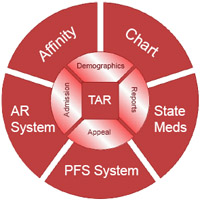 |
USC Medical Center: Utilization Review Tracking System Analysis
Introduction
Saga Technologies helps one of the nation?s highest-volume hospitals to assess, plan and propose the revision and
web-enabling of one of its central revenue-generating systems. The Saga team demonstrated that by updating the software
and hardware platform of this decade-old system, revising the document and workflow processes and replacing several manual
processes with electronic information transfer and validation, USC Medical center could achieve an unprecedented improvement
in the accuracy and productivity of its Utilization Review activities.
The Client
LAC (Los Angeles County)-USC Medical Center is one of the nation?s largest public hospitals, as well as the largest medical
training center in the country. Staffed by more than 450 full-time faculty of USC?s Keck School and approximately 850 medical
residents in training, the hospital treats close to 800,000 patients, delivers 10,000 babies and admits 250,000 people in its
emergency room each year.
With an average inflow of 140 admitted patients per day, the Utilization Review (UR) System of the LAC-USC Medical Center is
entrusted to serve as an efficient, centralized, high-capacity hub that ensures both the optimal treatment of patients and the
timely recovery of funds for the hospital through its designated payment sources.
The Challenge
Almost a decade old, the UR System had become cumbersome due to obsolete hardware, unsupported software and
dependency on manual processes. This situation jeopardized the organization?s performance in processing Treatment
Authorization Requests (TARs) for reimbursement from the hospital?s payment sources. The hospital needed a plan for a
re-designed UR System that would dramatically reduce the task-related pitfalls on the micro level and bring about macro level
efficiencies to improve the overall productivity of the UR system. Performance would be crucial, as the department had over
7,000 employees across multiple departments who are all potential users of the application. Security was another key design
concern, as some data would need to be visible only to LADCFS employees due to HIPAA regulations.
The department needed a thorough analysis and recommendation addressing this challenge to be completed within a 5-month
timeframe.
The Solution
This ambitious project began with an exhaustive analysis of all UR system users and processes. The existing UR System relied
on the orchestration of forms, approvals, correspondence, validations and reporting from several departments including,
admission, UR clerical, UR nursing, the patient financial office, the consolidated business office, legal and 3rd party contractors.
The Saga team conducted in-depth interviews with each of these departments and developed a process document that charted
the relative impact, bottleneck potential and critical needs and obstacles for each one. Once this step was completed, an
analysis of the UR system?s component processes was conducted, followed by a proposed workflow and process
implementation plan that utilized web-enabled functionality to connect data flow, forms processing and communication via one
centralized system. In addition to integrating the four legacy hospital information systems (Affinity, HBOC, PFS and Meds), the
UR System was segmented into the following nine modules: User Management, Patient, Admission, Eligibility, TAR, AR, Appeal,
Litigation, Report and Administration. Each module represented a distinct process integral to the effective processing of TARs.
To rein this complex system into a manageable format for its users, several role-based interfaces were presented,
incorporating maximum ease, relevancy and efficiency.

The Benefits
With a working project plan in hand, USC Medical Center moved one step closer to realizing its vision of a smooth procedural
and information flow throughout the entire UR process. Paper-heavy processes could be replaced by electronic transmission of
information. Forms processing could be performed via a user-friendly GUI instead of manual transcription. Field and
information validation and verification could occur automatically in real-time through a single integrated database. All of these
features would in turn shorten the turnaround required to process TARs and recover funds more efficiently for the hospital.
On the process level, implementing this plan would help the organization enjoy increased work efficiency using less resources,
as well as improved accuracy and data integrity. From an output standpoint, the department would be able to process a higher
volume of TARs and appeals. Operationally, the system would require less maintenance, as well as enjoy an unprecedented
level of security. USC Medical Center now has a plan of action to greatly enhance its bottom line by reducing lost opportunities
and increasing the rate and amount of incoming revenue.
Technologies Utilized
ASP.NET, C#.NET, HTML, JavaScript, XML, Web Service, Oracle9i Database Server
‹‹ Back
to Case Studies
|